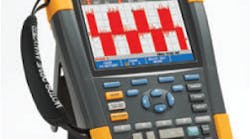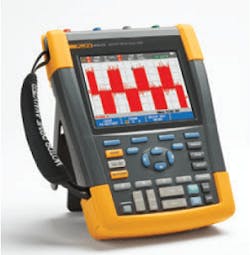Fluke MDA-510 and MDA-550 motor drive analyzers simplify complex motor-drive troubleshooting, saving time and eliminating setup hassles.
Variable-frequency drive (VFD) troubleshooting can be a time-consuming and complicated process, with many opportunities for mistakes that can reduce the reliability of the tests. “We thought we had this application covered with the ScopeMeter,” says Erik Gervedink Nijhuis, senior product planner, Fluke. “But as motor drives become more common, we noticed many users didn’t fully understand how to use the ScopeMeter on them. Motor drives require deeper knowledge and the tweaking of settings, and some measurements are almost impossible to make in a good way.”It doesn’t help that making motor drive measurements is not a daily task at most facilities. But checking installations, monitoring and diagnosing drives is a crucial task for reliability.
For example, the cable from the drive to the motor has to withstand high voltage and high-speed switching. If the wrong cable is used, it may result in overshoots that, over time, damage the motor. If the installation isn't checked, motor life may be shortened and the motor might be replaced without identifying the root cause of the failure.
To ease the task of making consistent, accurate drive measurements, Fluke has introduced a drive-specific version of the ScopeMeter. The new MDA-510 and MDA-550 motor drive analyzers simplify troubleshooting on single- and three-phase motor-drive systems by providing guided testing that enables technicians to quickly capture the most important measurements. They eliminate the hassle of setting up complex measurements, simplifying the troubleshooting process and delivering reliable, repeatable test results.
Both models include special algorithms and measurement guides that allow technicians who are less familiar with drives and oscilloscopes to set the correct parameters and save the same screen to a report. “It’s repeatable over time and with different team members,” says Gervedink Nijhuis.
Technicians simply select a test, and the step-by-step guided instructions show precisely where to make voltage and current connections, while the preset measurement profile ensures that all necessary data is captured for each motor-drive section, from the input to the output, the DC bus, and the motor itself.
MDA-550 includes a kit with a brush for measuring motor shaft voltage. “Fast changes indicate voltage buildup and flashover that may damage motor bearings,” adds Gervedink Nijhuis. “The test is automated, so users can see the build-up and frequency of discharge.”
Key measured parameters include voltage, current, DC bus voltage level and AC ripple, voltage and current unbalance and harmonics (MDA-550 only), voltage modulation, and motor shaft voltage discharges (MDA-550 only).
Extended harmonics measurements identify the effects of low- and high-order harmonics on electrical power systems. “The drive analyzers’ harmonics functionality goes beyond the standard harmonic, which is up to 3 kHz, and goes all the way to 150 kHz to detect issues in the drive active front end, where you may get higher-frequency harmonics that affect the filters on other devices,” explains Gervedink Nijhuis.
Like a regular ScopeMeter, the MDA-500 Series has full 500 MHz oscilloscope, meter and recording capabilities for a complete range of electrical and electronic measurements on industrial systems.
“All the functions are covered, including ripple as a separate measurement, output imbalance, input imbalance and voltage modulation. You can see overshoot and compare it to the motor rating to get a lifetime indication of the motor condition,” says Gervedink Nijhuis. “The MDA-510 and MDA-550 give plants that would have and use a ScopeMeter a tool that’s faster and more consistent for motor drive analysis. And it offers plants that wouldn’t use a ScopeMeter a way to perform really complex measurements without having to understand all the bells and whistles.”





